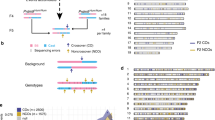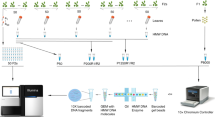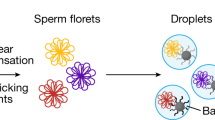Abstract
Crossover between the human sex chromosomes during male meiosis is restricted to the terminal pseudoautosomal pairing regions. An obligatory exchange occurs in PAR1, an Xp/Yp pseudoautosomal region of 2.6 Mb, which creates a male-specific recombination 'hot domain' with a recombination rate that is about 20 times higher than the genome average1,2,3. Low-resolution analysis of PAR1 suggests that crossovers are distributed fairly randomly4. By contrast, linkage disequilibrium (LD)5 and sperm crossover analyses6 indicate that crossovers in autosomal regions tend to cluster into 'hot spots' of 1–2 kb that lie between islands of disequilibrium of tens to hundreds of kilobases7. To determine whether at high resolution this autosomal pattern also applies to PAR1, we have examined linkage disequilibrium over an interval of 43 kb around the gene SHOX8. Here we show that in northern European populations, disequilibrium decays rapidly with physical distance, which is consistent with this interval of PAR1 being recombinationally active in male meiosis. Analysis of a subregion of 9.9 kb in sperm shows, however, that crossovers are not distributed randomly, but instead cluster into an intense recombination hot spot that is very similar in morphology to autosomal hot spots. Thus, PAR1 crossover activity may be influenced by male-specific hot spots that are highly suitable for characterization by sperm DNA analysis.
This is a preview of subscription content, access via your institution
Access options
Subscribe to this journal
Receive 12 print issues and online access
$209.00 per year
only $17.42 per issue
Buy this article
- Purchase on Springer Link
- Instant access to full article PDF
Prices may be subject to local taxes which are calculated during checkout




Similar content being viewed by others
Accession codes
References
Rouyer,F. et al. A gradient of sex-linkage in the pseudoautosomal region of the human sex chromosomes. Nature 319, 291–295 (1986).
Rappold, G.A. The pseudoautosomal regions of the human sex-chromosomes. Hum. Genet. 92, 315–324 (1993).
Page, D.C. et al. Linkage, physical mapping, and DNA sequence analysis of pseudoautosomal loci on the human X and Y chromosomes. Genomics 1, 243–256 (1987).
Lien, S., Szyda, J., Schechinger, B., Rappold, G. & Arnheim, N. Evidence for heterogeneity in recombination in the human pseudoautosomal region: high resolution analysis by sperm typing and radiation-hybrid mapping. Am. J. Hum. Genet. 66, 557–566 (2000).
Daly, M.J., Rioux, J.D., Schaffner, S.F., Hudson, T.J. & Lander, E.S. High-resolution haplotype structure in the human genome. Nature Genet. 29, 229–232 (2001).
Jeffreys, A.J., Kauppi, L. & Neumann, R. Intensely punctate meiotic recombination in the class II region of the major histocompatibility complex. Nature Genet. 29, 217–222 (2001).
Goldstein, D.B. Islands of linkage disequilibrium. Nature Genet. 29, 109–111 (2001).
Rao, E. et al. Pseudoautosomal deletions encompassing a novel homeobox gene cause growth failure in idiopathic short stature and Turner syndrome. Nature Genet. 16, 54–63 (1997).
Watterson, G.A. On the number of segregating sites in genetical models without recombination. Theor. Popul. Biol. 7, 256–276 (1975).
Nei, M. & Li, W.-H. Mathematical model for studying genetic variation in terms of restriction endonucleases. Proc. Natl Acad. Sci. USA 76, 5269–5273 (1979).
Cargill, M. et al. Characterization of single-nucleotide polymorphisms in coding regions of human genes. Nature Genet. 22, 231–238 (1999).
Halushka, M.K. et al. Patterns of single-nucleotide polymorphisms in candidate genes for blood-pressure homeostasis. Nature Genet. 22, 239–247 (1999).
Baird, D.M., Jeffreys, A.J. & Royle, N.J. Mechanisms underlying telomere repeat turnover, revealed by hypervariable variant repeat distribution patterns in the human Xp/Yp telomere. EMBO J. 14, 5433–5443 (1995).
Schiebel, K. et al. Elevated DNA sequence diversity in the genomic region of the phosphatase PPP2R3L gene in the human pseudoautosomal region. Cytogenet. Cell Genet. 91, 224–230 (2000).
Lewontin, R.C. The interaction of selection and linkage. I. General considerations; heterotic models. Genetics 49, 49–67 (1984).
Sajantila, A. et al. Genes and languages in Europe: an analysis of mitochondrial lineages. Genome Res. 5, 42–52 (1995).
Slatkin, M. Linkage disequilibrium in growing and stable populations. Genetics 137, 331–336 (1994).
Laan, M. & Paabo, S. Demographic history and linkage disequilibrium in human populations. Nature Genet. 17, 435–438 (1997).
Pritchard, J.K. & Przeworski, M. Linkage disequilibrium in humans: models and data. Am. J. Hum. Genet. 69, 1–14 (2001).
Kalaydjieva, L. et al. Patterns of inter- and intra-group genetic diversity in the Vlax Roma as revealed by Y chromosome and mitochondrial DNA lineages. Eur. J. Hum. Genet. 9, 97–104 (2001).
Hill, W.G. & Robertson, A. Linkage disequilibrium in finite populations. Theor. Appl. Genet. 38, 226–231 (1968).
Jeffreys, A.J., Murray, J. & Neumann, R. High resolution mapping of crossovers in human sperm defines a minisatellite-associated recombination hot spot. Mol. Cell 2, 267–273 (1998).
Jeffreys, A.J., Ritchie, A. & Neumann, R. High resolution analysis of haplotype diversity and meiotic recombination in the human TAP2 recombination hot spot. Hum. Mol. Genet. 9, 725–733 (2000).
Sved, J.A. Linkage disequilibrium and homozygosity of chromosomal segments in finite populations. Theor. Popul. Biol. 2, 125–141 (1971).
Morton, N.E. Outline of Genetic Epidemiology (Karger, Basel, Switzerland, 1982).
Jeffreys, A.J., MacLeod, A., Tamaki, K., Neil, D.L. & Monckton, D.G. Minisatellite repeat coding as a digital approach to DNA typing. Nature 354, 204–209 (1991).
Jeffreys, A.J. et al. Complex gene conversion events in germline mutation at human minisatellites. Nature Genet. 6, 136–145 (1994).
Su, A., Wu, Y., Sifri, C.D. & Wellems, T.E. Reduced extension temperatures required for PCR amplification of extremely A+T-rich DNA. Nucleic Acids Res. 24, 1574–1575 (1996).
Ellison, J.W. et al. PHOG, a candidate gene for involvement in the short stature of Turner syndrome. Hum. Mol. Genet. 6, 1341–1347 (1997).
Acknowledgements
We thank the many UK volunteers and the Saami and Romani communities for contributing semen and blood samples, and J. Blower, A. Kozlov and G. Vershubsky for coordinating sample collection. We also thank J. Brookfield, F. Calafell, Y. Dubrova, M. Jobling, Z. Rosser, N. Royle, T. Slingsby, J. Wetton and colleagues for advice and comments on the manuscript. This work was funded by grants to A.J.J. from the UK Medical Research Council, the Wellcome Trust and the Royal Society.
Author information
Authors and Affiliations
Corresponding author
Ethics declarations
Competing interests
The authors declare no competing financial interests.
Rights and permissions
About this article
Cite this article
May, C., Shone, A., Kalaydjieva, L. et al. Crossover clustering and rapid decay of linkage disequilibrium in the Xp/Yp pseudoautosomal gene SHOX. Nat Genet 31, 272–275 (2002). https://doi.org/10.1038/ng918
Received:
Accepted:
Published:
Issue Date:
DOI: https://doi.org/10.1038/ng918
This article is cited by
-
Detection of SHOX gene aberrations in routine diagnostic practice and evaluation of phenotype scoring form effectiveness
Journal of Human Genetics (2017)
-
Analysis of common SHOX gene sequence variants and ∼4.9-kb PAR1 deletion in ISS patients
Journal of Genetics (2014)
-
Identification of the first PAR1 deletion encompassing upstream SHOX enhancers in a family with idiopathic short stature
European Journal of Human Genetics (2012)
-
Preimplantation genetic diagnosis (PGD) for SHOX-related haploinsufficiency in conjunction with trisomy 21 detection by molecular analysis
Journal of Assisted Reproduction and Genetics (2011)
-
Identification of a Gypsy SHOX mutation (p.A170P) in Léri-Weill dyschondrosteosis and Langer mesomelic dysplasia
European Journal of Human Genetics (2011)



